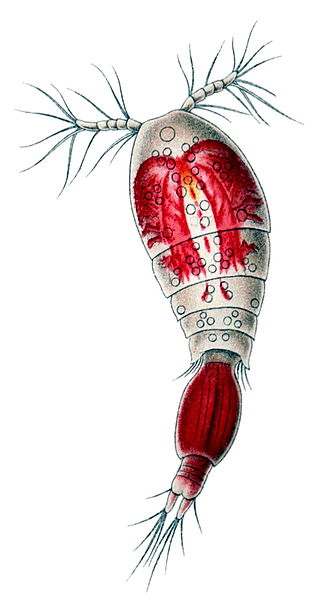
Calanus is a genus of marine copepod in the family Calanidae. The genus was split in 1974, with some species being placed in a new genus, Neocalanus. The following species are recognised:

Cyclops is one of the most common genera of freshwater copepods, comprising over 400 species. Together with other similar-sized non-copepod fresh-water crustaceans, especially cladocera, they are commonly called water fleas. The name Cyclops comes from the Cyclops of Greek mythology, as they have a single large eye; in Cyclops, the eye may be either red or black.

Oncaea is a genus of copepods. The genus contains bioluminescent species. Unlike other bioluminescent copepods, Oncaea have an internal (non-secreted) bioluminescence. Oncaea contains the following species:

Acartia is a genus of marine calanoid copepods. They are epipelagic, estuarine, zooplanktonic found throughout the oceans of the world, primarily in temperate regions.

Calocalanus is a genus of copepods, the only genus in the family Calocalanidae:
Centropagidae is a family of copepods in the order Calanoida. Its members are particularly known as plankton in coastal waters and in fresh water in Australia and southern South America. They are also found on subantarctic islands and in lakes in Antarctica.
Pontellidae is a family of copepods in the order Calanoida, containing the following genera:

Pontella is a marine copepod genus in the family Pontellidae. It is an organism that bears three lenses in the eye. The outer has a parabolic surface, countering the effects of spherical aberration while allowing a sharp image to be formed.

Copilia is a genus of copepods in the family Sapphirinidae. The eyes in members of this genus have two lenses, arranged like those in a telescope.

Euaugaptilus is a genus of copepods. The genus contains bioluminescent species.
Centropages is a genus of copepods in the family Centropagidae with 34 known marine species.
Oithona is a planktonic crustacean genus found in marine, brackish, fresh water environments. Oithona has been described as the most ubiquitous and abundant copepod in the world's oceans. It was first described by Baird in 1843 using the species Oithona plumifera as taxon type.
Candacia is a genus of copepods in the order Calanoida. It is the only genus in the monotypic family Candaciidae.
Rhincalanus is a genus of crustaceans belonging to the monotypic family Rhincalanidae.








